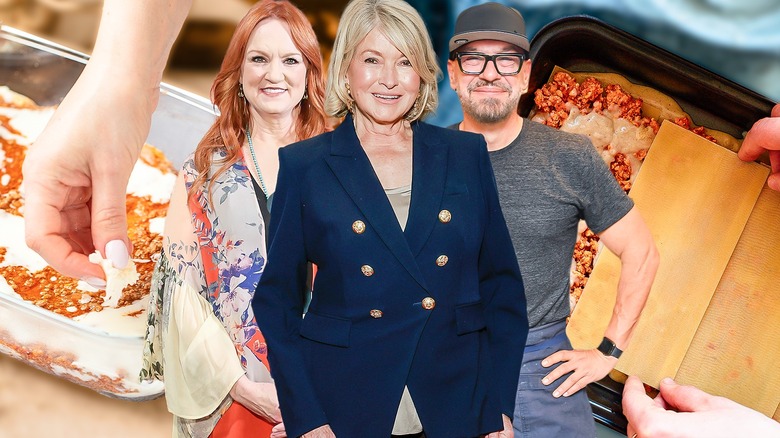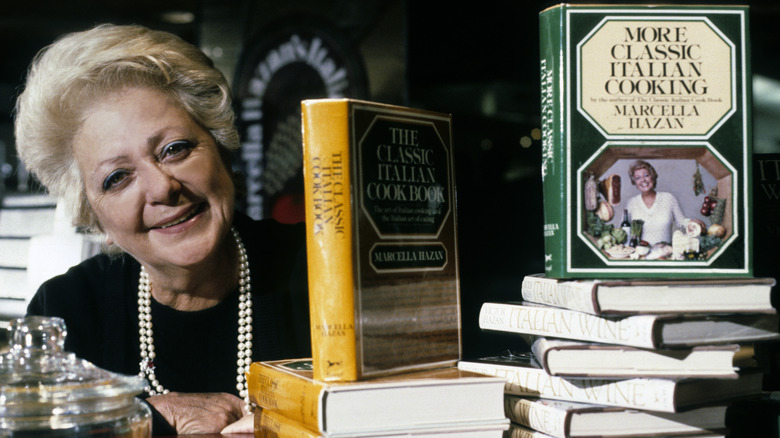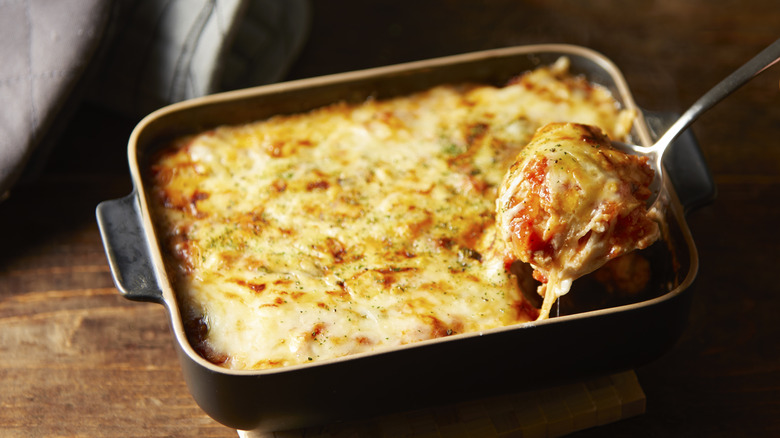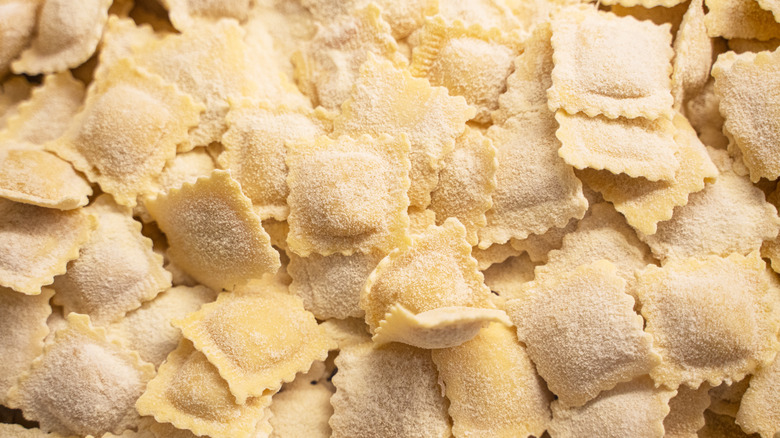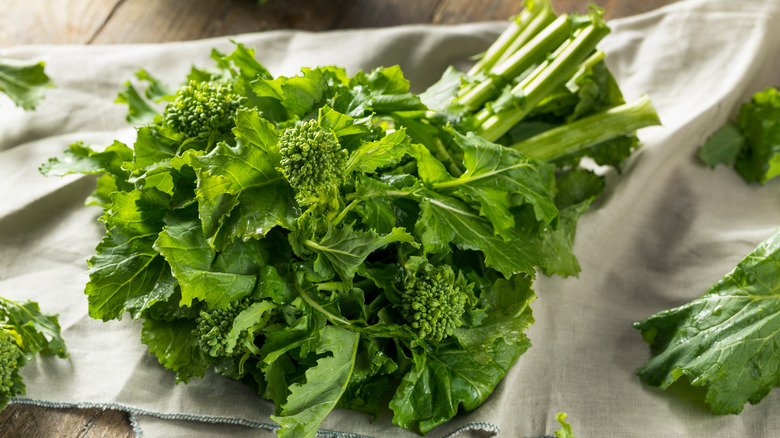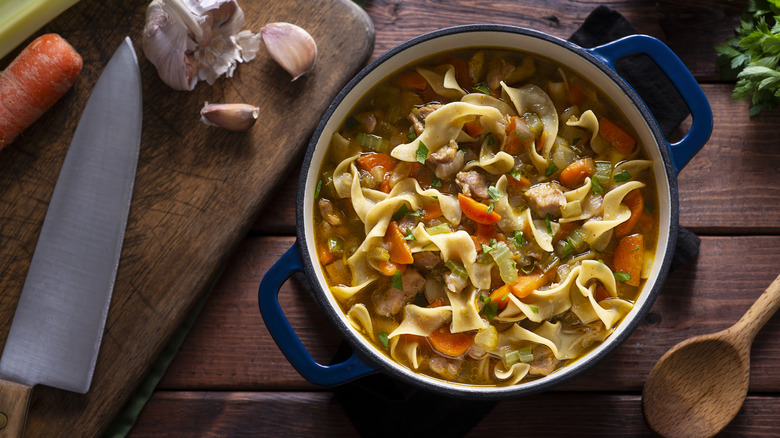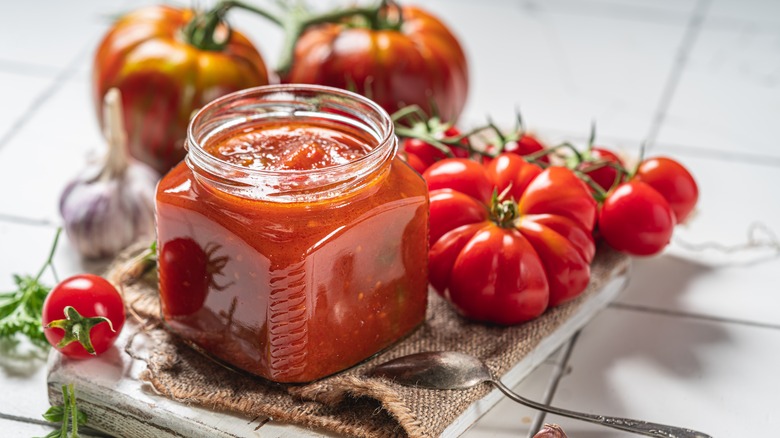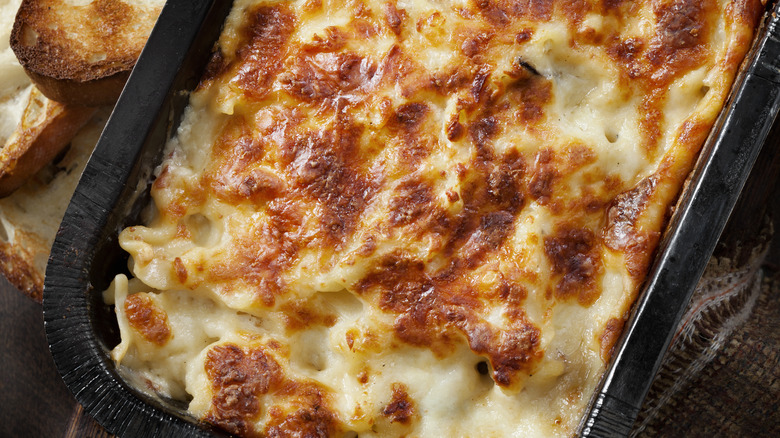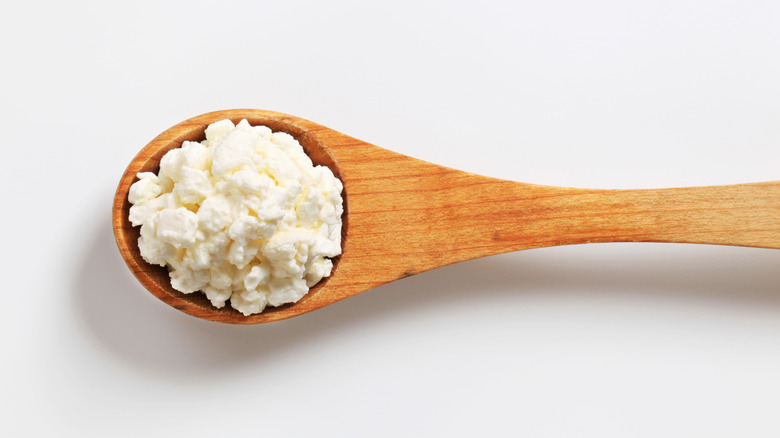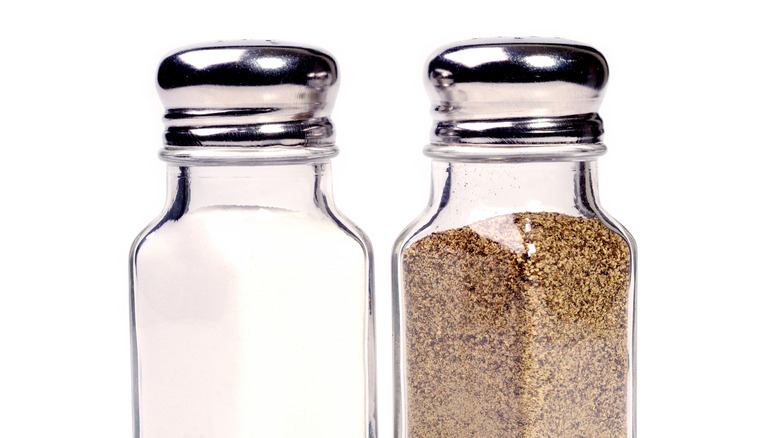12 Celebrity Chef Tips To Make The Best Lasagna
Lasagna is the weeknight dinner savior, the knight in shining armor that comes to the rescue and provides an entire family of four, nay, five people, with a delicious, nutritious meal that just needs to be popped in the microwave or oven for a few minutes –- as long as someone thought ahead and prepared it over the weekend. This harmonious blend is just the ticket after a hard day's work. Achieving the intended effect, however, requires some attention to ingredients and fundamental techniques.
At its core, a good lasagna relies on the careful layering of essential components: pasta sheets, tomato sauce, ground beef, and cheese. But, nuance matters. For instance, the amount of sauce you choose to put in your lasagna may be just as important as the variety of tomatoes you use. Equally, the type of meat you opt for makes a difference in the overall flavor of the dish. Meanwhile, experimentation with new and unusual ingredients is always encouraged.
When so much is at stake, we find that it helps to look to culinary luminaries for guidance. So, let's consider some of the best celebrity chef tips on how to make the best lasagna, once and for all.
Giada De Laurentiis: add butter
It is widely known that butter enhances flavor. This quintessential dairy product contains more fat than milk, which is why it's able to add so much richness and depth of flavor to the dishes it graces. This effect is no less enticing in lasagna, where Giada De Laurentiis uses butter to enhance the bubbly cheesiness of the top of this baked dish, as she explains on her website, Giadzy. Hey, if a few dollops of butter can be used this way in risotto (as it should), then why not in lasagna as well?
The best news about this trick is that it's simple, quick, and easy, and you don't have to remember to add an extra step somewhere in the middle of your recipe, complicating things further. No, Giada De Laurentiis simply plops some good butter (not this time, margarine), on top of her lasagna before putting it in the oven. The butter melts into the cheese as it cooks, infusing the rest of the layers with its signature richness.
Marcella Hazan: make your own lasagna sheets
There is a big difference in the flavor and texture of dried, store-bought pasta and fresh, homemade pasta. And you guessed it -– the homemade stuff is much better than the store-bought stuff. That's why Marcella Hazan, author of the "Essentials of Classic Italian Cooking," made her own fresh lasagna sheets from scratch.
Her reasoning was that lasagna comes out best when the pasta sheets are extremely thin, which is not necessarily what you get with boxed lasagna sheets. But, there are many other perks that come with the fresh pasta territory, the foremost of which is that fresh pasta cooks more quickly, so there is no need to parboil your lasagna sheets before layering them up with the rest of the ingredients. Moreover, they provide a silkier, smoother texture than boxed lasagna, which can sometimes end up as overly chewy globs of slime, especially when being reheated after spending some time in the fridge.
Of all the fresh pasta you can make at home, lasagna sheets are perhaps the quickest and simplest to prepare. There's no need to pass them through your pasta maker in complicated motions. These are not fusilli we're talking about. They're just flat sheets of pasta that just need some flattening out.
Michael Symon: Mix up the cheeses
Mozzarella and ricotta are typical cheeses you might find in a lasagna, either alone or together. But Michael Symon takes his lasagna a step further, using both regular, low-moisture mozzarella as usual, but also adding dollops of fresh mozzarella to the top of the lasagna at the end, along with a few extra layers of parmesan. This yields an incredibly cheesy lasagna, but since fresh mozzarella remains mild-tasting even when cooked, it doesn't overwhelm the dish.
To ensure this method doesn't ruin your meal by causing the fresh mozzarella to turn to gummy rubber in the oven, which can happen when it's overcooked, Symon cooks the lasagna with aluminum foil, removing it only in the last 10 minutes. This allows the mozzarella to remain fresh and stringy as it melts, toasting a bit at the end and taking on that nice golden color that makes cheese so enticing. Be sure to grate the mozzarella, as hard as it may be, because this ensures an even bake.
But there is also an important generic lesson to be gained here, which is that it's okay to experiment with a variety of cheeses, as long as you cover the top of the lasagna with foil to protect it from overcooking.
Giada De Laurentiis: swap lasagna sheets for ravioli
Giada De Laurentiis might be one of the most significant personalities in Italian cooking in America right now. So, when she gives us advice on how to make lasagna, we listen, even if it may sound outrageous at first. Specifically, we're talking about Giada's idea to swap lasagna sheets for ravioli pasta. Yes, ravioli, those little square bites of pasta that come with all sorts of fillings.
Before you balk, consider this: Giada specifically suggests the use of ricotta-filled ravioli for her lasagna, which obviates the need for adding a layer of ricotta to the lasagna. So, actually, this idea saves time if nothing else. As for the rest of the lasagna, just prepare it the way you normally would, then layer some uncooked, fresh ricotta ravioli on top of the marinara or meat sauce instead of plain old lasagna sheets. The sauce will give the dish plenty of moisture for the ravioli to cook.
You can also have fun with this recipe in other ways. Try different flavors of ravioli, including ricotta with spinach, to sneak in a vegetable. Use taleggio and radicchio to change up the cheese and sneak in more vegetables. And why not? Once you know this works, you could even use meat-filled ravioli and do away with your meat layer. The possibilities are as vast as the ravioli fillings.
David Tanis: fill it with broccoli rabe
Although traditional lasagna is made with a layer of ground beef, there is no rule saying this dish has to be made with meat, especially if you're a vegetarian. Indeed, replacing the meat with one or more vegetables is a common tactic, and one that works especially well is broccoli rabe lasagna, as professional chef and cookbook author David Tanis has proven.
We recognize that at first glance, this may seem a little odd. Many vegetarian lasagnas use spinach or zucchini, both of which lend themselves well to seamlessly fitting into lasagna layers without creating bumps. But broccoli? That would be bump city. That's why Tanis actually cooks the broccoli first, then takes the leaves and grinds them into a pesto, which he then spreads on the lasagna. He also finely chops up the rest of the broccoli so that it matches the size and bulk of ground beef, allowing it to join the rest of the lasagna without standing out.
You can assemble this vegetarian lasagna by starting with lasagna sheets at the bottom of the pan, adding a layer of béchamel followed by the ricotta mixture, and finishing with the chopped broccoli topped with the broccoli pesto. Repeat the process until all ingredients have been used up.
Danny Freeman: turn it into soup
If you love lasagna and you love soup, Danny Freeman has just the recipe for you: lasagna soup. Although this may seem like a pretty new concept, or at least unfamiliar, we assure you that there is no mystery surrounding the recipe. Indeed, it is mainly made with the usual lasagna ingredients –- pasta, tomato, cheese, beef –- plus broth. Quite literally lasagna soup.
To make it, you may want to swap out the usual ricotta for a different cheese; ricotta risks getting lost and melting away in the hot broth. Freeman for one, uses fresh mozzarella, which tends to melt in the soup while broadly maintaining its composition. As for the rest, just brown your ground beef, add the tomato sauce, and then pour in the broth along with some torn-up pieces of lasagna sheets. We say lasagna sheets because this is lasagna soup, but really, any type of pasta will do the trick. You just need it to soak up some of the broth so that the texture turns into a stew -– not too thick but not too thin either.
Finally, add the cheese at the end, giving it enough time to melt and provide the top of your stew with a nice gooeyness. As a bonus, while a regular lasagna preparation might set you back 1 or 2 hours, this version should be ready in less than 30 minutes.
Giada De Laurentiis: Don't go easy on the sauce
We all know that tomato sauce is a key ingredient in a good lasagna, whether you're making a meat-lovers version or a vegetarian recipe. But, one thing many people forget, is that the tomato sauce isn't just there for flavor. It plays a key role in developing the texture of the dish, specifically by allowing the lasagna sheets to cook and soak in its moisture in the oven but also to create a firm crust on top, as De Laurentiis patiently explained to Prince William after he told her about his unsuccessful attempt to cook the dish.
One thing to remember is that more sauce also means more moisture, which tends to gather and pool when the lasagna is straight out of the oven. But as it cools, the sauce and the rest of the ingredients firm up together, making it easier to cut into the baked meal without creating a catastrophic mess. As such, it's important to let the lasagna rest for at least 10 minutes after pulling it out of the oven before cutting into it.
Ina Garten: substitute ground beef for turkey sausage
Most run-of-the-mill lasagna recipes call for ground beef. Sometimes with the addition of sausage, ground pork, or even veal. But Ina Garten uses turkey sausage, and there is absolutely nothing wrong with that. Quite the contrary. According to Healthline, turkey contains less saturated fat than beef, making it a healthier choice for those concerned about heart health. It also tends to contain fewer calories than beef.
But fewer calories doesn't mean Ina Garten expects us to give up on flavor. For that, she uses a mixture of spicy and mild turkey sausage, which she supplements with sautéed onions and garlic and plenty of basil and freshly ground pepper. Just be sure to taste that turkey before you start pouring on the salt. Turkey sausage is prepackaged meat, which means it already contains some amount of salt. It's for you to determine just how much there is and how much more is then needed to fully flavor the dish.
Martha Stewart: Bake it in a cast-iron pan
A 9x13 glass baking dish is a pretty standard contraption for cooking lasagna. But there are other vessels you can use, and a different one might just change the fate of your lasagna. Martha Stewart uses an enameled cast-iron or ceramic pan, and so should you, if you can find one in the same size. As she explained in an Instagram post, these materials are better at retaining heat than glass, giving your lasagna an even treatment during cooking, and allowing its edges to become nice and crispy.
In the same post, she also provided a bonus tip: Cover the lasagna during cooking to avoid the need for parboiling the lasagna noodles. This works because the cover keeps more moisture in the lasagna during the cooking process, allowing it to soak up enough water to cook thoroughly directly in the oven. And if you get to the end of the cooking process and those edges still aren't crispy, just remove the cover and cook for a little longer, open-air. That should do the trick.
Alex Guarnaschelli: broil it for crunch
The first thing that comes to mind when thinking of lasagna might not be the crunch factor. After all, this is primarily a pasta dish, and pasta is best served soft, silky, and maybe even a bit al dente, which is more of a chewy effect than a crunchy one. But, if you've ever had the bad luck of sampling a slimy, limp lasagna noodle, you'll know why that crunch is actually very important in the final product. It's the kind of thing that really seals the deal on a good lasagna.
To that end, Alex Guarnaschelli got to work to create a lasagna recipe that would deliver the coveted crunch every time. What she came up with was nothing short of spectacular, and it only requires one additional yet simple step to achieve. That step is to place the lasagna under the broiler for a few minutes toward the end of the cooking process. This is what browns that cheese on top, turning it golden, bubbly, and indeed, crunchy — just make sure you don't broil it the whole time. This could quickly dry out the lasagna, leaving you with a heap of bricks too hard to bite into.
Ree Drummond: include cottage cheese
While ricotta and mozzarella may be lasagna mainstays, there's no reason you can't experiment with other soft, mild cheeses, and there are plenty out there to choose from. Ree Drummond proves it by selecting cottage cheese for her lasagna, an unlikely candidate, but one that works quite well if you get the steps right.
The trick is to mix it with beaten eggs, grated Parmesan, chopped parsley, and some salt before arranging it in your baking dish in layers with lasagna noodles, sliced mozzarella, meat sauce, and a dusting of parmesan on top. On her website, Drummond calls this the "best lasagna ever," and whether you agree with that statement or not, you have to admit it's pretty darn good. In fact, although you might not specifically taste the cottage cheese itself, you'll notice a certain je ne sais quoi about this lasagna. The unusual inclusion of the cottage cheese, as well as the breakfast sausage that goes in along with the ground beef.
Giada De Laurentiis: season each layer
Bland lasagna is something that cannot be easily fixed. Because it's made up of a series of layers, simply sprinkling salt on top after cooking just isn't going to cut it. Giada De Laurentiis avoids bland lasagna altogether by thoroughly seasoning each layer in the moment she prepares it and well before she begins to assemble the dish.
That's because each lasagna is only as good as its component parts, so the best way to succeed in making this dish is by ensuring that each part of it already tastes good on its own. If even a single layer falls out of line, it risks creating a pocket of blandness in your lasagna. So, in practical terms, what does that mean? Start by salting the water in which you parboil the lasagna sheets. This will allow the seasoning to properly soak through the pasta. Then, be sure to season the sauteed meat, even if you've chosen to add tomatoes. You can even add extra flavoring here, including onions, garlic, carrots, and celery.
If you're using a bechamel sauce, don't forget to season that, too. The butter and whole milk will give it a lot of flavor, but they're no panacea without the help of salt. Finally, you might think that cheese has enough salt, but this isn't necessarily the case. Ricotta, for one, tends to need some seasoning to bring out the flavor, as does fresh mozzarella.
